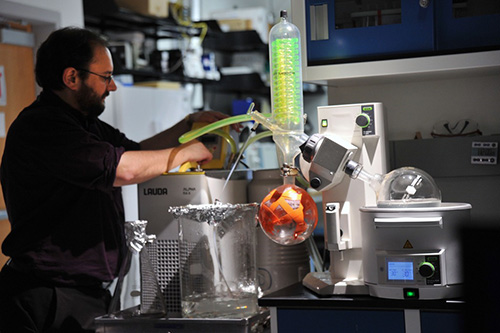
The use of rotary evaporation for extraction and preparation methods of cannabis products is undisputed within the industry to provide the purest concentrations of Tetrahydrocannabinol (THC). After a winterization process, rotary evaporation operates as a filtration step, which can be repeated with different solvents and boiling points per the desired product’s purity and residual levels. A rotovap system places its contents under vacuum to ensure a lower boiling point for the compound, from which solvents can be condensed and filtered.
This is possible by contents being distributed in a thin film around the inside of a boiling flask, allowing quicker evaporation rates with the vacuum allowing lower boiling points. Specific solvents (although Ethanol is most common) can be targeted by their respective boiling points without overheating the THC concentration. This method is most frequently used for distilling oil or resin THC concentrates and lower THC concentrates used in edibles.
The winterization and rotary evaporation process is considered superior to other methods for these extractions, because this allows a more precise control of evaporation rate and amount, ultimately meaning greater vacuum control to insure a consistent concentrate. This dewaxing increases potency, removes water, and thins the consistency of the concentrate, which can increase the versatility of the product.
Growing research indicates there may be further means of purification via chromatography, adding a step between two different rotary evaporations to create concentrates of 97% THC or higher. This may be achievable on a large pharmaceutical scale or smaller scale, if desired, though upfront costs would be considerable. Other costs to consider with the rotary evaporation system include vacuum (diaphragm) pump to create the vacuum and recirculating chiller for liquid cooling.
While this process may seem highly artificial, the desired THC concentrate is initially the base resin that forms predominantly on the upper buds of the plant, due to receiving the most sunlight. This means the amount of THC per actual individual flower/bud can vary dependent on the plant’s original placement. Comparatively, creating extracts allows for a more homogeneous product with more consistent doses for medicinal users, while also requiring less consistent use and an availability of varying strengths for individual needs.
References
"AI Rotovaps for Solvent Recovery Fractional Distillation." November 4, 2015. Accessed March 30, 2017. http://aivacovens.com/level-up-your-purge-game-wi...
Bilotta, Jim, and Alison Wake. "Evaluation of Evaporative Techniques in the Extraction and Preparation of Cannabis Oil." June 23, 2016. Accessed March 30, 2017. http://www.labmanager.com/white-papers-and-applic...
Hernandez, Cid Maria Vanessa, and Houten Dennis Van. Cannabis plant isolate comprising /\9-tetrahydrocannabinol and a method for preparing such an isolate. US Patent WO2013165251 A1, filed May 3, 2013, and issued November 7, 2013.
Joseph, Andy. PDF. New York: Apeks Supercritical, June 16, 2016.
Smith, Owen. "Explaining Cannabis Concentrates." July 31, 2015. Accessed March 30, 2017. https://cannabisdigest.ca/explaining-cannabis-con...



